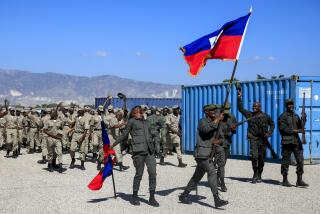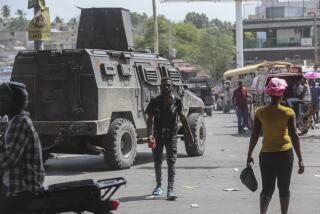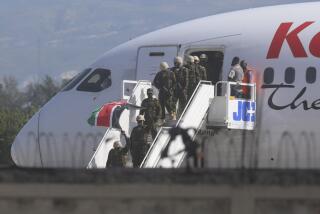In Haiti, U.S. troops embrace a new role
Reporting from Port-Au-Prince, Haiti — Cite Soleil looks like a place where an American soldier might be expected to fight. An impossibly crowded warren of tin-roofed shacks, open sewers and blind alleys, it is one of the poorest slums in the Americas, with a long history of unrest, crime and violence.
So picture the scene: Just as dawn was breaking Sunday, a battle-hardened platoon from the Army’s 82nd Airborne Division rolled into the area behind a well-armed convoy of Brazilian soldiers attached to the United Nations’ longtime peacekeeping mission in Haiti.
Smoke from cooking and trash fires filled the air, reducing visibility in places to less than a city block but failing to cover the smell of rotting garbage and human waste. Pigs and feral dogs rooted through trash.
It was an ominous setting for what turned out to be an entirely benign event. As soldiers traded fist bumps with children, good-natured adults formed orderly lines to receive the first major shipment of food aid to reach Cite Soleil, a neighborhood in Haiti’s capital, since the Jan. 12 earthquake.
“Whatever they give us, we’re satisfied,” said Wilna Vertus, a 21-year-old mother of six, “because we don’t have anything.”
The U.S. military has been in Haiti since the day after the magnitude 7.0 quake, providing much of the muscle behind getting aid into the country and out to the population. For troops here, many of them veterans of combat in Iraq and Afghanistan, this is not the mission they trained for. Some critics have suggested that they are not getting enough aid to enough people fast enough.
Still, it has cast the troops in a gratifying, if somewhat unfamiliar, role as peaceful warriors who save lives rather than take them.
“It’s kind of cool for a change,” said Sgt. Eric DeJesus, a 26-year-old from New Jersey who was at the wheel of a Humvee as the convoy made its way into Cite Soleil. “I mean, we do this in Iraq, but at the same time there we’re killing people, you know what I mean?”
There are now 3,700 U.S. troops in Haiti, plus at least 9,000 military personnel on ships just off the coast. So far, they have been involved almost entirely in aid deliveries, with very little work in security, which is mostly being handled by Haitian police and the U.N.’s 7,000-strong peacekeeping force.
Given the history of U.S. intervention in Haiti, which included a 20-year occupation in the early 20th century, Haitians might be expected to be resentful or fearful of a large contingent of U.S. soldiers and Marines. So far that does not seem to be the case.
The prevailing attitude was summed up by Saintalis Frisnel, a 37-year-old man with four children he can barely feed and cannot afford to educate. He was clutching a pair of liter bottles of water and half a dozen high-protein biscuits he had just received from American soldiers. It was not enough, he said. It could hardly feed his family for even a day. But he wasn’t complaining.
“They’re doing good for me,” he said of the Americans. “If it was my government, I could never get a chance to touch one of these crackers.”
Cite Soleil, which has a population estimated between 400,000 and 500,000, escaped the worst of the quake’s destruction, perhaps because there is so much less to destroy than in more affluent parts of Port-au-Prince. The best houses in the area, which is wedged between the city’s harbor and airport, are concrete bunkers with tin roofs, perhaps 100 square feet in all. Most show little or no sign of damage. Frisnel said his house, made almost entirely of corrugated tin, fell down, but no one was seriously hurt.
As is the case for many of Haiti’s poorest citizens, his house was too flimsy to kill anyone.
Still, suffering is the norm in Cite Soleil, and the earthquake has only made things worse. What little work people had is mostly gone. It is harder for them to replace whatever they have lost, because they have so little to begin with.
Befitting the community’s status as Haiti’s largest slum, Sunday’s aid delivery was overseen by the commanding generals of U.S. and U.N. forces in Haiti.
At a news conference on a blocked-off road, Army Lt. Gen. P.K. Keen, the U.S. commander, defended the military against accusations that it was moving too slowly, although he acknowledged that much more needed to be done.
Keen said that far more people in the capital need food assistance than are being reached. However, neither Keen nor his U.N. counterpart, Brazilian Gen. Floriano Peixoto, could say how many people were being helped so far.
“The aid . . . is being pushed out,” Keen said. “But again, the need is tremendous. Every day is a better day than yesterday, and tomorrow will be a better day than today.”
Keen said he didn’t know how long American forces would be needed in Haiti, but added, “I think it would be a tragedy -- a tragedy -- to not have sufficient forces to feed the people.”
Keen said it made sense for the U.S. military to play a leading role in providing assistance after a disaster whose death toll has not been calculated, though the Haitian government said Sunday that more than 150,000 bodies had been buried so far by a company hired to collect corpses.
Keen’s soldiers seemed to agree with him, although they said it was not the most natural role for them to play.
“We’ve got a lot of combat veterans who deployed to Iraq or Afghanistan,” said 1st Lt. Jay Rosen of Union Bridge, Md. “For them, this is a whole new experience.”
That was not entirely true for Sgt. 1st Class Chad Lewis, who had been to Haiti before on a humanitarian mission. But he has also had more than his share of combat deployments, including stints in Iraq and Kosovo. And when he arrived in Haiti, he said, he was loaded up with ammunition and prepared for the worst.
Since then, he’s been thinking of taking off his protective gear “and walking around like everybody else.”
“Part of me loves the combat job,” he said, “because that’s what I do. . . . But I’m also a softy. I think anybody with a heart would want to be here helping.”
mitchell.landsberg @latimes.com
More to Read
Sign up for Essential California
The most important California stories and recommendations in your inbox every morning.
You may occasionally receive promotional content from the Los Angeles Times.










